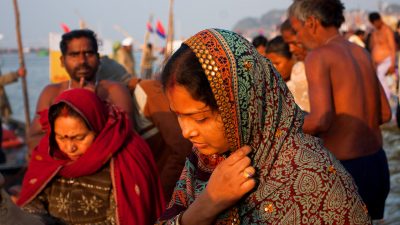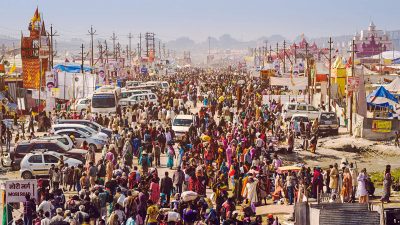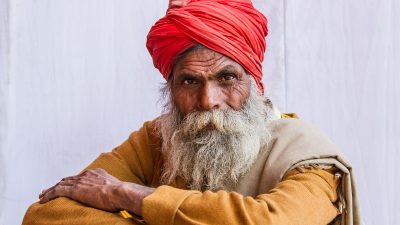THE PILGRIMAGE OF THE KUMBH MELA
Travel in India – 13 days
The Kumbh Mela is an epic Hindu pilgrimage, where the faithful gather, every three years, to immerse themselves in a sacred river. The location where the ceremony takes place always changes according to the astral position of Jupiter and the Sun. The origins of this pilgrimage are lost in Hindu legend and mythology. Demons and gods competed for the Kumbh, the sacred Urn that contained Amritha, the nectar of immortality. The god Jayanta, who turning into a crow managed to steal it and then fled, prevailed. Chased by demons, he stopped to rest 4 times on the Earth and at each stop, a few drops of Amritha came out of the vase, wetting the soil and it is said that the 4 sacred cities were born from these drops. Probably the Kumbh Mela is one of the most famous Hindu ceremonies in the world, certainly the most populous event on the planet, because it lasts several weeks and a total of millions of people participate.
This itinerary has been specially designed to allow participationin the Kumbh Mela. The itinerary allows you to visit the main tourist attractions of northern India and the best conscious tourism projects enclosed in a single tour. With this itinerar, you will immerse yourself in the architectural wonders, the strong religious sense, the human and cultural variety, condensing the magic of an Indian adventure in an introspective journey, from which you often return different. The journey will begin with a visit to the capital New Delhi, in particular of the old town and you will be accompanied by young guides from local NGO that recovers street children by providing them education, a job and access to health services. The journey continues with the city of Nawalgarth, a little touristy area, but that will amaze you with its refined Haveli, a colorful bazar and the eco lodge. You will continue your journey to Jaipur, the famous pink city and capital of Rajasthan, to then move to the city of Agra and visit its famous mausoleum, the Taj Mahal. From Agra, you will go to Lucknow, where you will have the opportunity to visit the colossal tomb of Bara Imambara built in 1784 by Asaf-ud-Daula, a Nawab and the Bhul-bhulaya or a labyrinth full of corridors, rooms, secret passages with some of these blind-bottomed. From Lucknow, you will move to Prayag (the current Allahâbâd) to immerse yourself in the place where the waters of the Ganges, Yamuna and the mythical Saraswati underground rivers meet to attend the event of the Kumbh Mela, the most important, incredibile and indescribable Hindu religious festival. You will have the opportunity to attend this celebration during the Maghi Purnima festival, an important moment in the celebrations but a little less crowded than the 3 royal baths, Shahi Snan, Makar Sakranti, Mauni Amawasya and Basant Panchami. During this occasion, there will not be a real procession of Akharas or Sadhu Naga, but it will be much easier and equally propitious to meet and interact with the Sadhu and spiritual guides. The tour will end with a stop at the sacred city of Varanasi, on the banks of the sacred river Ganges, which is considered the home of the god Shiva. It is also one of the fundamental pilgrimage places for Hindus. The city also has an important historical relevance with its 3,000 years, it is one of the oldest cities in the world. The silk produced here is famous all over the world, as gold and silver threads are inserted within the complex weave of the fabric: an inevitable purchase for shopping lovers and at the same time an asset of great artistic value. The trip will end on the last day with a boat ride on the Ganges river, enjoying the beautiful sunset, to pay homage to this glorious divinity, thanks to which the experiences lived will be unforgettable.
JOURNEY OVERVIEW AND PROGRAM DETAILS
1° DAY: DELHI
Arrival at the airport of New Delhi, meeting with our operators at the terminal exit and trasfer to the hotel. In the afternoon, guided tour of Lutyens district, car ride to see the Parliament Building, the Presidential Palace and the India Gate. Visit of the famous of Humayun Mausoleum, an architectural marvel. The city tour ends at the Qutb complex, with a visit to the Qutb Minar, with its five floors and 72 meters high, and at the Iron Column . Return to the hotel.
Overnight stay in New Delhi.
2° DAY: DELHI – NAWALGARH
In the morning (10 a.m.), visit to the poor neighborhood of Paharganj, in Old Delhi, led by the young people of Salaam Balaak Trust ONG, who saves the children from the street, instructs them and trains them professionally. The City Walk itineraries aim to bring to light the tragic reality of street children and to show the world from their perspective. The walk takes place in the Paharganj district and in the areas around the railway station, accompained by a former street child who was helped by the NGO and is now in employment. This gives you the unique opportunity to visit the city with exceptional guides. In the afternoon, transfer by car to Nawalgarh (about 5 hours), in the Sekhawati region in the Rajasthan, where you can walk and visit some of the 200 Hveli, the ancient and sumptuos Indian residences, present in Nawalgarh. The wonderful frescoes of the Haveli are true work of art.
Overnight stay in Nawalgarh (B).
3° DAY: NAWALGARH
After breakfast, departure to discover Nawalgarh and its most beautiful Haveli (traditional houses). Free lunch and then in the afternoon camel ride through the countryside of the surroundings of Nwalgarh to Dundlod. Visit of the village and return to the hotel. In the evening, dinner accompained by a small concert of Indian classical music by local musicians.
Overnight stay Nawalgarh (B,D).
4° DAY: NAWALGARH – JAIPUR
After breakfast, a cooking class will be held by an eco-lodge family member lunch preparation. In the afternoon transfer by car to Jaipur (about 3 hours and half), the largest city in Rajasthan and a symbol of magnificence and abundance. Founded in 1727 by Jai Singh II, it was the first Indian city with a reticular plan. Capital under the kingdom of Kachwaha clan, the city is an ideal tourist destination.
Overnight stay in Jaipur (B,L).
5° DAY: JAIPUR
After breakfast, visit to the Hawa Mahal on the way to Amber Fort. Transfer by jeep to the castle. After lunch, visit at Anokhi museum, that shows how much the handicrafts plays an essential role in the rural economy of India. In the afternoon, visit to the Royal Palace and to the ancient city; places full of charm, culture and architecture, with wonderful fortresses, majestic buildings, peaceful temples and beautiful Haveli (ancient stately homes). A refined handicraft and a spectacular goldsmith tradition increase the uniqueness of the “pink city”. The lush gardens and flower beds add serenity to the landscape. Together, these ingredients create a picturesque environment that bewitches visitors. Walking through the streets of this unique city makes it easier to understand local history.
Overnight stay in Jaipur (B).
6° DAY: JAIPUR – AGRA
After breakfast, transfer to Agra by highway (about 4 hours). Arrival in Agra around lunchtime. Lunch at Sheroes hangout cafè, a small restaurant supported by a local NGO in favor of women victims of acid attacks. After lunch, visit of Taj Mahal (closed on Fridays), one of the most famous and visited monuments in India, built for will of the Mughal emperor Shahjahan in memory of his beloved wife Mumtaz Mahal. The imposing white marble building is today an universal symbol of love and romance and it is one of the seven wonders of the world. It was built in 1653, a date symbolically reported in the 16 gardens and 53 fountains present; it required 16 years of work and the commitment of thousand of craftsmen.
Overnight stay in Afra (B,L).
7° DAY: AGRA – LUCKNOW
In the morning transfer by car to Lucknow (about 5 hours). Transfer to the hotel for check in. Later, visit to the colossal tomb of Bara Imambara built in 1784 by Asaf-ud-Daula, a Nawab; the title Nawab or Nababbo (in Italian indicates a very rich and wealthy person) was originally attributed to a governor or a viceroy and then became a high title attributed to Muslim nobles. Next we will visit the Bhulbhulaya or labyrinth full of corridors, rooms, passages with some of these blind-bottomed.
Overnight stay in Lucknow (B).
8° DAY: TRANSFER TO ALLAHABAD
After breakfast, transfer to Allahabad (about 5 hours). Check in at the hotel or tented camp. Free afternoon for a first contact with the Hindu meeting of the Kumbh Mela. Allahabad, the ancient holy city of Prayag, has always been considered a center of culture and religion during the many millennia of Indian history, and for this reason was particularly targeted by Muslim invaders subjects of the emperor Akbar, who even turned the name into Allahabad (the city of Allah).
Overnight stay in Allahabad (B,L,D).
9° DAY: ARDH KUMBH MELA ALLAHABAD
These two days will be dedicated to what is considered the biggest religious gathering on earth, the Kumbh Mela, which is celebrated every three years in rotation in the sacred cities of Allahabad, Haridwar, Ujjain and Nasik. During the days established by the brahmins consulting the Indian lunar calendar, thousands of Hindu pilgrims go to the banks of the Sangam, a mythical place where the water of the three sacred rivers of northern India (Ganga, Yamuna and Saraswati) meet, to complete the rite. From January to March 2019 the Ardh Kumbh Mela will be held in Allahabad, where long the banks of the rivers, faithful and pilgrims gather to cleanse themselves from all sins by taking a dip/bath (snan) in the sacred waters and reaching liberation (Moksha). Families, young, old, children from all over India, from all castes, poor and rich, will come together and gather to participate. The event will also bring sadhus, priests, ascetics to the famous Naga Sadhu who live and turn naked covered only by ash. We will have the opportunity to attend this celebration during the feast of the Maghi Purnima (19 February) an important date in the celebrations.
Overnight stay in Allahbad (B,L,D).
10° DAY: ARDH KUMBH MELA ALLAHABAD
These two days will be dedicated to what is considered the biggest religious gathering on Earth, the Kumbh Mela, which is celebrated every three years in rotation in the sacred cities of Allahabad, Haridwar, Ujjain and Nasik. During the days established by the brahmins consulting the Indian lunar calendar, thousands of Hindu pilgrims go to the banks of the Sangam, a mythical place where the water of the three sacred rivers of northern India (Ganga, Yamuna and Saraswati) meet, to complete the rite. From January to March 2019 the Ardh Kumbh Mela will be held in Allahabad, where long the banks of the rivers, faithful and pilgrims gather to cleanse themselves from all sins by taking a dip/bath (snan) in the sacred waters and reaching liberation (Moksha). Families, young, old, children from all over India, from all castes, poor and rich, will come together and gather to participate. The event will also bring sadhus, priests, ascetics to the famous Naga Sadhu who live and turn naked covered only by ash. We will have the opportunity to attend this celebration during the feast of the Maghi Purnima (19 February) an important date in the celebrations.
Overnight stay in Allahabad (B,L,D).
11° DAY: TRANSFER TO VARANASI
After breakfast, transfer by car (about 3 hours) to Varanasi. Check in at the hotel on the banks of Ganges, to rest. Following, visit of Varanasi. The luxurious vegetation on the banks of the river increases the charm of the city. It is the ideal destination for travelers fascinated by Hindu beliefs, customs, culture and ideas. Here it is possible to live authentic experiences of Hindu life.
Overnight stay in Varanasi (B).
12° DAY: VISIT TO VARANASI
After breakfast, guided tour of the sacred city, whichboasts many attractions. It is rich of ancient temples such as Kashi Vishwanath, Kal Bhairava, Durga Kund and Annapoorna. Moreover, Varanasi is an important center of art, handicrafts, education and culture. There are the Benares main Ghats, or steps that lead to the Ganges, many of which are used for ritual ablutions, others for cremations. A legend or mythological episode is often associated witht the bleachers; others are private. The most important step for cremations is Manikarnika Ghat, also known as Mahasmasana, included in the tourist tour. It is believed that burning bodies in these special places is the right way to achieve Moksha, salvation. In the evening, we will witness the famous religious ritual of Ganga Aarti Puja, which takes place every day at sunset at Dasaswamedh Ghat, near the Kashi Vishwanath temple and is a very choreographic ceremony. It is performed on a stage by a group of young Pandits, wrapped in saffron-colored tunics, who hold the ceremonial dishes in front of them.
Overnight stay in Varanasi (B).
13° DAY: DEPARTURE FROM VARANASI
Transfer to the airport and departure with international flight (via Delhi).
ACTIVITIES
- explore old Delhi through the eyes of young guides formed by a local NGO;
- discover the famous monuments and architectural works of Delhi;
- visit the traditional village of a city less known such as Nawalgarh and its precious Haveli;
- discover the pink city of Jaipur, the capital of Rajasthan;
- visit the famous Taj Mahal, one of the most famous buildings in the world;
- visit the colossal tomb of Bara Imambara;
- attend one of the most famous religious gatherings in the world, the Kumbh Mela;
- visit the sacred city of Varanasi;
- partecipate in the Ganga aarti Puja of Varanasi;
- walk along the banks of the sacred river Ganges.
RICHIEDI INFORMAZIONI PER QUESTO TOUR
SOCIAL AND ENVIRONMENTAL IMPACT
All the itineraries to attend the Kumbh Mela have been designed in order to promote direct or indirect benefits for local communities, environment and cultural heritages. When possible, we have selected traditional accommodations sensible to social and environmental issues, following general principles and practices of responsible tourism.
North India is an area full of contradictions, on the one hand you’ll see the luxurious Haveli (famous stately homes) and the period buildings redeveloped and transformed into luxury hotels, and on the other hand conditions of extreme poverty, in a mix that you will see coexist.
In choosing the selected structures, it is very important to respect traditional local architecture, taking advantage of the monetary flow deriving from toursim and contribuiting to the protection of historic buildings, choosing some of these as accommodation during travel. The economic impact of tourism allows to renovate and preserve some of the buildings, fortresses and historic residences that otherwise would be abandoned and conveyed with a responsible tourism tour instead can also be entrusted to local communities and NGOs. This tour includes many well-known tourist destinations and lesser-known places, just to be able to distribute the economic flow produced fairer. In addition, staying in traditional places rich in history, allows you to fully immerse yourself in the culture of the place, in order to create an authentic meeting with local communities, local NGOs and voluntary assosiations that will show tourists the reality of the places visited, through their many important activities. The NGO selected in Delhi, with children recovered from the street and transformed into guides, will make you reflect on the important issue of exploitation, telling you about theri personal experiences and alternative life that they have managed to build thanks to the work of the NGO; they will show you the reception centers and illustrate the projects undertaken by the organization, which for years has been offering assistance to these children and facilitating their access to education and work.
In Nawalgarh, the eco lodge used is involved in responsible tourism and supports various community development projects through its economic revenues. In Agra instead, we will support, thanks to your visit and to “a solidarity coffee”, women victims of acid attacks and you will carry out a responsible tour that explains the history of the Taj Mahal mausoleum. The contribution of Conscious Journeys to these communities ensures theirmaintenance and strengthening of autonomy, the ability to hone their skills and create a network that covers all of Rajasthan, so as to expand the benefits drawn from responsible tourism. We also offer a Responsible Shopping, which allows you to purchase products directly from the artisans, without any need for intermediaries who make profits, often unreasonable, to the detriment of producers. In the same way, we encourage stays with local families, so that the economic benefits go directly to the communities.
In addition, with a contribution of 70 euros you will support the development of projects in favor of one of the most marginalized tribal communities in India, the Kattunayakan community of the Nilgiri district in the states of Tamil Nadu and Kerala. Projects supporting these tribes are focused on two main aspects: the protection of biological and cultural diversity and the promotion of regular education for the children of the community.
TIPS FOR THE DEPARTURE
During the journey, it is advised to follow a conduct which respects local culture to avoid any hassles or unwanted troubles along your journey. In particular, avoid displayx of affection in public places, such as hugging, kissing etc., as this behaviour is not appreciated by local people. Some
tribes community, especially village elders, are sensitive to photos. As a good behavior requires, it is always good to ask for permission before taking a photo.
It is also important to follow a certain dress code. There are basically two reasons why it is recommended to be careful about what clothes you wear here. The first reason is to avoid hurting local people’s feelings and second is to protect yourself from the unstable weather conditions. Besides, mosquitoes are a huge issue and it is advised to keep your arms and legs covered ( don’t forget to bring mosquito nets and repellents, especially for backwaters cruises).
India’s time zone is +5:30 hours so you could have some problems with the jet lag. It is advised that you get onto this time zone as soon as you leave home and try to eat and sleep according local time. Also, if you reach India early in the day, try to stay awake – this will help the body’s internal clock to reset.
A conscious approach to travel requires a considerable capacity and willingness to adapt and adjust to the local environment and culture. If you wish to travel with us, we request you to be open enough to experience local culture, religious and traditions without bias and preconceptions you might have before the departure and which belong to our Western cultural way of thinking.
Exploring with fresh eyes, with patience and openness, you will be able to access the real essence of Sri Lanka’s cultural heritage through the places and people you meet. With this little effort, you will truly enjoy the beauty of a totally different culture and the wonder of nature.
Once you make this little effort, you’ll be truly able to enjoy of the beauty of a completely different culture and of the wonders of the nature, of the solemnity of temples and palaces, of the sacredness of the waters of the infinite rivers that flow through this magical land, and upon returning home to remember the incredible experiences lived.
HOTELS
For the duration of the tour, we selected traditional and beautiful hotels, almost always the period ones and with excellent services. A scrupulous selection has been made for all the structures, to guarantee the minimum social and environmental impact.
TRANSPORT
Private vehicles or mini-buses with air conditioned according to the number of participants from Varanasi to Delhi for the return by international flight.
INDIA WHEN TO GO
The season from October to March is generally the best time to visit Northern India (including the regions of Uttar Pradesh, Madhya Pradesh, West Bengal). While Rajasthan is characterized by a dry climate all year round, where the influence of the monsoon can occur between July and August only with occasional, intense but short-lived thunderstorms. The maximum temperatures recorded between October and March range around 26° to 36° C. The monsoons, bearers of rain, occur mainly from May until September.




